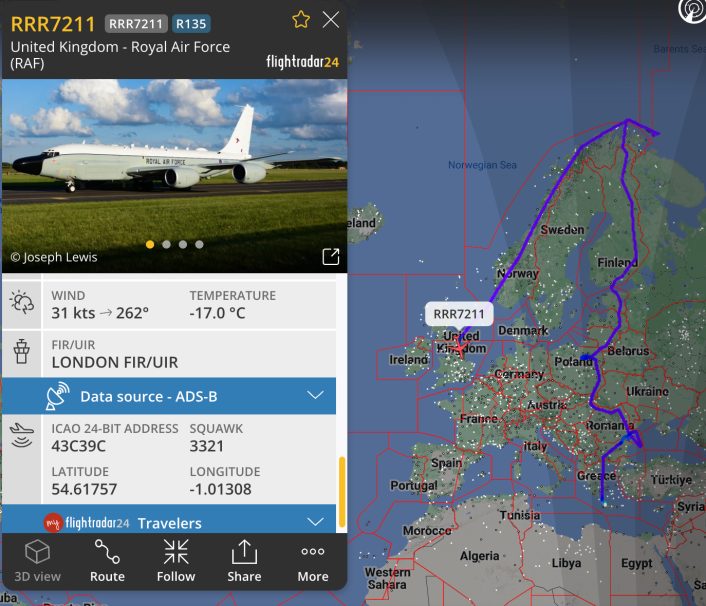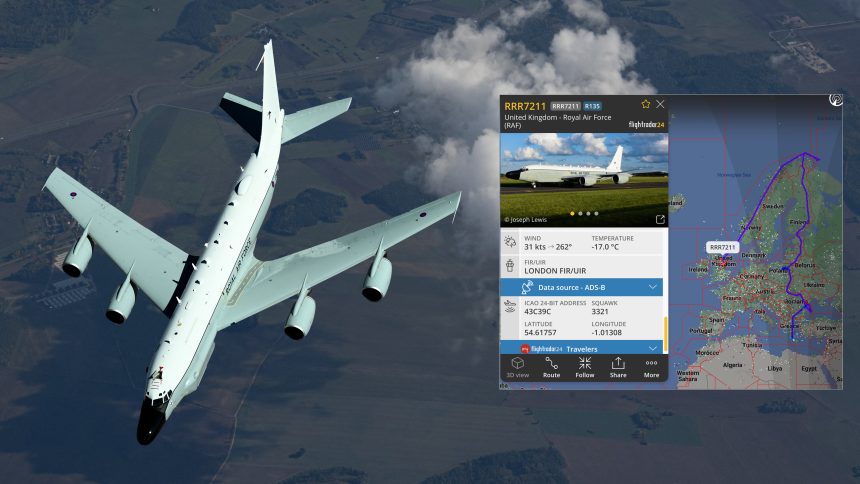A Royal Air Force RC-135W Rivet Joint has become the first allied aircraft to complete a full transit along NATO’s eastern border, from the southernmost point of Greece to the northernmost point of Finland.
On Oct. 11, 2024, a Royal Air Force (RAF) RC-135W Rivet Joint belonging to 51 Squadron, based at RAF Waddington, the hub of the RAF‘s Intelligence, Surveillance, Target Acquisition and Reconnaissance fleet made history becoming the first of its kind to fully traverse NATO’s eastern borders from the Mediterranean’s southernmost point in Greece to the far north of Finland. According to the service, the mission underscored the UK’s unwavering commitment to NATO’s defense and highlighted the critical role played by British intelligence, surveillance, and reconnaissance (ISR) forces in securing Europe’s skies.
The mission launched from Souda Bay, Crete, Greece, an important NATO airbase that has long been a strategic hub for the Alliance’s southern operations. From there, using radio callsign RRR7211, the aircraft headed north and flew along the entire length of NATO’s eastern border, overflying Greece, Romania, Bulgaria, Hungary, Slovakia, Poland, the Baltic States, Finland and Norway. The mission also included some standard “racetracks”, over the Black Sea, during the southern part of the “trip”; and over the Barents Sea off Kola Peninsula in the High North.
After completing the mission, the aircraft safely returned to its home base at RAF Waddington, Lincolnshire, marking a successful and high-profile operation.
Noteworthy, the entire mission could be tracked online on flight tracking websites as the intelligence gathering aircraft had its Mode-S/ADS-B transponder turned on throughout the mission.
USAF RC-135U Combat Sent ELINT aircraft #JAKE27 and RAF RC-135W Rivet Joint SIGINT aircraft #RRR7211 patrol the entire length of the alliance’s eastern border, “snooping” into the Kola Peninsula, Leningrad Military District, Kaliningrad, Belarus, Ukraine, and the Black Sea. pic.twitter.com/khskOZndBC
— Olli Suorsa (@OlliSuorsa) October 11, 2024
Interestingly, a U.S. Air Force RC-135U Combat Sent was also operating in the Baltics as the British RC-135W flew along the border: the U.S. asset, which specializes in the collection and analysis of electronic intelligence (ELINT), particularly focusing on enemy radar systems, flew a “loop” around Kaliningrad Oblast before returning to RAF Mildenhall, UK.
A Landmark Moment for NATO and the RAF
Air and Space Commander, Air Marshal Marshall, hailed the RAF RC-135W (also known as the “Airseeker” in British service) achievement as a landmark moment for the RAF and NATO, emphasizing how it demonstrates the UK’s ongoing leadership within the Alliance.
“This marks a pivotal moment, highlighting the UK’s steadfast dedication to NATO”
The RC-135W Rivet Joint forms part of the RAF’s Intelligence Surveillance Target Acquisition and Reconnaissance (ISTAR) Force. As an electronic intelligence-gathering aircraft, it has the unique ability to absorb massive amounts of data during its missions. On-board analysts can quickly process, exploit, and disseminate that data, providing high-priority intelligence to both air and ground units in near real-time. This capability is essential for NATO’s operations, allowing the Alliance to maintain situational awareness and respond to potential threats as they arise.

The mission also served as a practical demonstration of the Rivet Joint’s ability to operate across various airspaces, communicating and coordinating with allied forces. “The Rivet Joint routinely flies along NATO borders, but completing this extensive journey in a single mission demonstrates the UK’s prominent role in safeguarding NATO airspace, alongside its US allies,” said one senior RAF official. This ability to rapidly project intelligence and surveillance power across vast distances is a critical component of NATO’s deterrence strategy, ensuring that the Alliance can monitor and counter threats across multiple fronts.
Interoperability and Collaboration within NATO
At the heart of this operation is the RAF’s long-standing commitment to working closely with NATO partners. The Rivet Joint’s ability to communicate with and operate alongside allied air forces is central to the UK’s strategy of ensuring seamless integration with NATO forces during joint missions. Officer Commanding 51 Squadron highlighted how beneficial this close collaboration with NATO allies is for operational effectiveness:
“Cooperating with NATO enables our crews to refine the tactics, techniques, and procedures needed to support major Combined Air Operations.”
The Rivet Joint’s mission provided a valuable opportunity for crews to practice these vital skills, ensuring they are fully prepared for real-world operations where time-sensitive information must be shared and acted upon quickly.
The ability to operate seamlessly with NATO forces is a testament to the strength of the RAF’s relationships with its allies, particularly the United States Air Force (USAF), which also operates RC-135 Rivet Joint aircraft. The long-standing partnership between the UK and the US within NATO’s intelligence-sharing network ensures that both nations can rely on each other’s assets to provide vital information in times of crisis.
Marking NATO’s 75th Anniversary
This historic mission also carries symbolic weight, coming as NATO celebrates its 75th anniversary. Over the past seven decades, NATO has grown into one of the world’s most successful and enduring alliances, built on a foundation of collective defense, shared values, and mutual trust. The Rivet Joint’s mission is a clear demonstration of the UK’s commitment to upholding these principles and supporting NATO’s evolving role in maintaining peace and stability in Europe.
Highlighting the strength of the enduring alliance through the RAF’s continued interoperability and cooperation in NATO’s air domain, this mission reaffirms the UK’s relationships with the United States and its European allies, showing the value of collective defense at a time of heightened geopolitical tensions.
“This mission underscores the vital role that NATO plays in defending our shared values and protecting our citizens,” said Air Marshal Marshall. “What better way to mark NATO’s 75th year than by demonstrating the strength of our alliance and the commitment of all its members to our common defense.”









